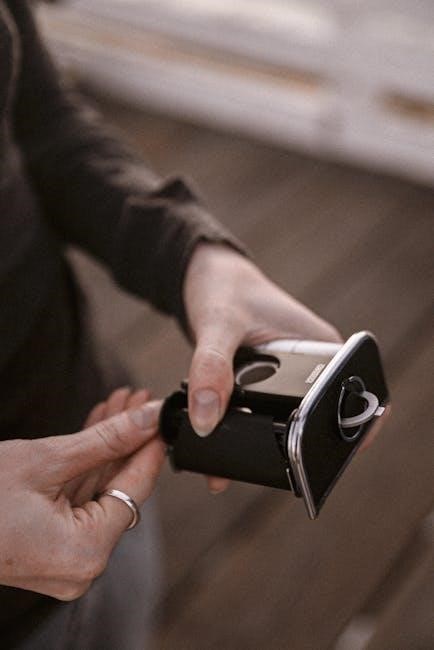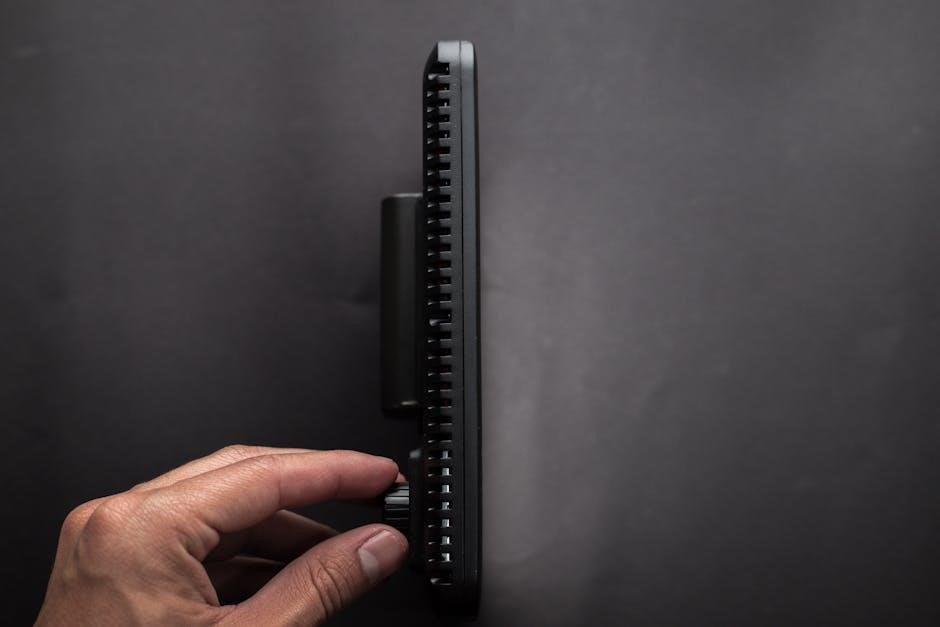Understanding your True freezer’s temperature control system is crucial for maintaining optimal performance, safety, and energy efficiency. This guide provides essential insights and step-by-step instructions to ensure proper setup and operation.

Installation and Setup
Position the freezer on a level surface, ensuring proper ventilation. Secure the temperature control unit and connect it according to the manual’s instructions. Avoid blocking air vents.
2.1 Locating the Freezer
Proper placement of your True freezer is essential for optimal performance and energy efficiency. Ensure the unit is installed on a level, stable surface to maintain even cooling. Keep it away from direct sunlight, heat sources, and moisture to prevent overheating and ensure accurate temperature control. Allow adequate clearance from walls and surrounding appliances to facilitate proper airflow. Avoid positioning the freezer near windows or in areas with significant temperature fluctuations. Ensure the location is well-ventilated to prevent heat buildup and maintain the factory-set temperature range of -10°F (-23.3°C) for freezers. Follow the manufacturer’s guidelines for installation to guarantee reliable operation and longevity of the appliance.
2.2 Initial Setup Steps
Begin by carefully unpacking the freezer and ensuring all components are undamaged. Place the unit in a suitable location as per the manufacturer’s guidelines. Level the freezer using adjustable legs to ensure even operation and prevent damage. Plug in the appliance and allow it to cool down to the factory-set temperature of -10°F (-23;3°C). Avoid placing food immediately; let the freezer stabilize for a few hours. Set the temperature control to the recommended setting for your needs. Refer to the manual for specific instructions on initializing advanced features or adjusting settings for high-altitude operation. Always follow the provided guidelines to ensure proper function and longevity of the appliance.
2.3 Connecting Temperature Controls
Connecting the temperature controls on your True freezer is a straightforward process. Locate the temperature control thermostat, usually found inside the unit or on the exterior. Ensure the thermostat is properly secured to the evaporator coil or air-sensing probe, depending on the model. For models with digital controls, connect the temperature probe to the control unit as specified in the manual. Secure all wiring and ensure proper connections to avoid malfunctions. If your freezer has a defrost system, ensure the temperature control is correctly linked to the defrost timer or heater. Test the system by adjusting the temperature and verifying the display or operation. Always refer to the specific model’s manual for precise connection instructions to ensure accuracy and safety.
Temperature Control System
The temperature control system in True freezers ensures precise temperature management, with factory-set defaults for optimal performance. It includes mechanical or electronic controls and defrost cycles for efficiency.
3.1 How It Works
The True freezer’s temperature control system operates by sensing the evaporator coil or air temperature, not the product temperature. It uses a thermostat or electronic control to regulate cooling cycles. When the set temperature is reached, the compressor stops, and the defrost cycle may begin. This cycle prevents frost buildup on the evaporator coil, ensuring efficient operation. The system automatically resumes cooling once the defrost cycle ends. This process maintains consistent temperatures, preserving food quality and safety. Proper functioning relies on accurate temperature sensing and correct control adjustments as outlined in the manual.
3.2 Types of Controls
True freezers feature two primary types of temperature controls: mechanical and electronic. Mechanical controls use a dial to set the desired temperature, while electronic controls offer digital displays and precise adjustments. Mechanical systems defrost during compressor off-cycles, whereas electronic controls often include an air-sensing probe that initiates defrost cycles based on temperature or time. Both systems ensure consistent temperatures, but electronic controls provide advanced monitoring and accuracy. Understanding the specific type of control in your freezer is essential for optimal performance and maintenance, as outlined in the manual. Proper use of these controls ensures efficient operation and extends the lifespan of your appliance.
3.3 Monitoring Temperature
Monitoring the temperature in your True freezer is essential to ensure optimal performance and food safety. The unit is equipped with a temperature control system that continuously tracks and adjusts the internal temperature. For precise monitoring, electronic controls feature a digital display showing real-time temperature readings, while mechanical controls rely on a dial indicator. The system uses an air-sensing probe to detect temperature changes, ensuring accurate readings and consistent cooling. Regularly check the display to verify that the temperature remains within the recommended range of -10°F to 0°F (-23.3°C to -17.8°C). Proper placement of the temperature probe is crucial for accurate monitoring, as it should reflect the actual product temperature inside the freezer.
Adjusting Temperature Settings
Adjusting the temperature settings on your True freezer ensures optimal performance and food safety. Locate the temperature control, typically found on the exterior or interior of the unit. For electronic controls, press the adjustment buttons to increase or decrease the set temperature. Mechanical controls feature a dial that can be turned clockwise or counterclockwise to adjust the temperature. Factory settings are usually around -10°F, but adjustments may be needed for specific storage requirements. After making changes, allow the freezer to stabilize for 24 hours before checking the temperature with a thermometer. Ensure the temperature remains between -10°F and 0°F (-23.3°C to -17.8°C) for ideal food preservation. Avoid setting the temperature too high to prevent food from thawing or spoiling.

Maintenance and Care
Regular maintenance ensures your True freezer operates efficiently and prolongs its lifespan. Clean the condenser coils periodically to prevent dust buildup, which can reduce airflow and performance. Inspect door seals for wear or damage to maintain proper temperature consistency. Clean the interior and shelves with mild soap and warm water, avoiding abrasive chemicals that may damage surfaces. Defrost the freezer as needed to remove ice buildup, following the manual’s defrosting instructions. Check and replace worn gaskets to maintain a tight seal. Schedule professional servicing annually to inspect the compressor, fan, and temperature control systems. Proper care ensures consistent cooling, energy efficiency, and optimal food preservation.

Troubleshooting Common Issues
If your True freezer isn’t cooling properly, check the temperature settings to ensure they’re within the recommended range. Verify that the doors are sealing correctly and not left ajar. If the compressor isn’t running, ensure the unit is plugged in and the circuit hasn’t tripped. Frost buildup on the evaporator coils may indicate a defrost issue. Check for blocked air vents, as poor airflow can cause temperature fluctuations. If the temperature control isn’t responding, refer to the manual for reset instructions or contact a technician. Addressing issues promptly prevents food spoilage and ensures efficient operation. Always unplug the freezer before performing any repairs to avoid electrical hazards.

Defrosting the Freezer
Regular defrosting is essential to maintain your True freezer’s performance and prevent excessive ice buildup. The defrost system is typically temperature-terminated, meaning it activates when a set temperature is reached. For manual defrosting, locate the defrost control, usually found near the temperature dial, and switch it to the defrost position. Allow the freezer to defrost completely before returning to normal operation. Remove all contents and store them in a temporary cooler. Avoid using sharp objects to scrape ice, as this may damage the interior. After defrosting, wipe down surfaces with a mild detergent and rinse thoroughly. Regular defrosting ensures efficient cooling and prevents frost from interfering with temperature regulation. Always refer to your manual for specific defrosting instructions.

Advanced Features
True freezers come equipped with advanced features designed to enhance performance and user convenience. Electronic temperature controls with LED displays provide precise temperature monitoring and easy adjustments. Some models include automatic defrost systems that ensure efficient operation by preventing ice buildup. Additional features may include energy-saving insulation, eco-friendly refrigerants, and smart sensors that optimize cooling based on internal and external conditions. Certain units offer dual temperature zones, allowing for customizable storage solutions. These advanced features not only improve functionality but also contribute to energy efficiency and environmental sustainability. Refer to your specific model’s manual for details on accessing and utilizing these enhanced capabilities.
Safety Precautions
When operating your True freezer, it is essential to follow safety guidelines to avoid potential hazards. Always unplug the unit before performing maintenance or repairs to prevent electrical shock. Avoid using mechanical devices to defrost, as this can damage internal components. Flammable refrigerants are used in some models, so never expose the unit to open flames or sparks. Keep the freezer away from water sources to prevent electrical accidents. Properly install and maintain the unit to ensure safe operation. Refer to your manual for specific warnings and precautions tailored to your model. Adhering to these guidelines will help protect both you and your equipment, ensuring a safe and efficient freezing environment.

Resources and Support
True Manufacturing offers comprehensive resources to support your freezer’s operation. Download detailed user manuals, installation guides, and technical specifications from the official website. For troubleshooting, refer to the dedicated support section or contact True’s customer service team via email or phone. Additional resources include FAQs, parts information, and maintenance tips to ensure optimal performance. Registered users can access model-specific guides and warranty details. Visit truemfg.com/support/manuals for direct downloads or to explore the extensive library of documentation tailored to your True freezer model. Utilize these resources to maintain efficiency, address issues promptly, and extend the lifespan of your equipment.

Leave a Reply
You must be logged in to post a comment.